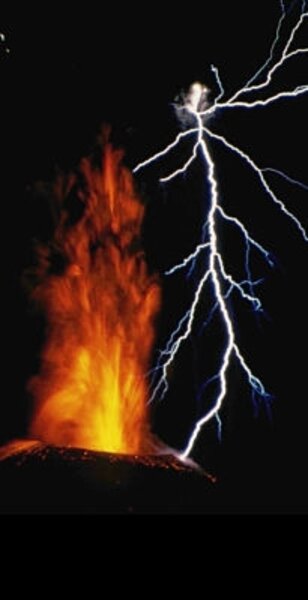If Mt. Redoubt blows, Alaskans may get a light show
Loading...
The volcano watch for Alaska's Mt. Redoubt continues apace.
According to the Anchorage Daily News:
An observation flight by scientists this afternoon reported no sign of ash emission yet, but discovered significant steaming from a new melt depression at the mouth of the summit crater....
That flight took place Jan. 30.
But towering clouds of ash aren't the only things to watch for if Redoubt romps. Lightning is another byproduct of such eruptions. In fact, Ronald Thomas and colleagues have suggested that volcanoes can act as "dirty thunderstorms."
Dr. Thomas is an electrical-engineering professor at New Mexico Institute of Mining and Technology in Soccoro. He focuses much of his work on devising techniques to map and study lightning.
The eruption in 2006 of another Alaskan volcano, Mt. Augustine, gave Thomas and researchers at the Alaska Volcano Observatory a chance to monitor the eruption's output of lightning. Applying some of the mapping techniques Thomas has developed, the team gathered what it called the most detailed information to date (as of February 2007) on volcanic lightning.
The scientists monitored four explosive bursts from the mountain over two days. Storms prevented the team from seeing the effects directly. But the radio detectors they set up uncovered a "spectacular" sequence of lightning activity. It came with the first, and largest, blast.
The team found two distinct types of discharges.
One presented their sensors with an almost constant stream of radio emissions. The team suggested that the radiation came from large numbers of small discharges that occurred near the summit as the hot ash and gas hurtled skyward.
The second type began three minutes after the biggest blast. For the ensuing 10 minutes, the researchers counted some 300 individual lightning strokes that appeared to drift along with the wind-driven ash plume. One of the last strokes occurred some 13 miles from the summit.
The team figured that the close-to-the-cone discharges occurred because the material ejected carried strong electrical charges from the get-go. As that material moved into the plume and away from the summit, colliding ash, rock fragments, and ice particles in the plume increased the electrical charge. This led to the additional discharges, which the team suggest took place mostly within the plume.
Volcanoes, the team wrote, "are known to release copious amounts of water, and may behave as 'dirty' thunderstorms." The results appeared in the Feb. 23, 2007, issue of Science.





